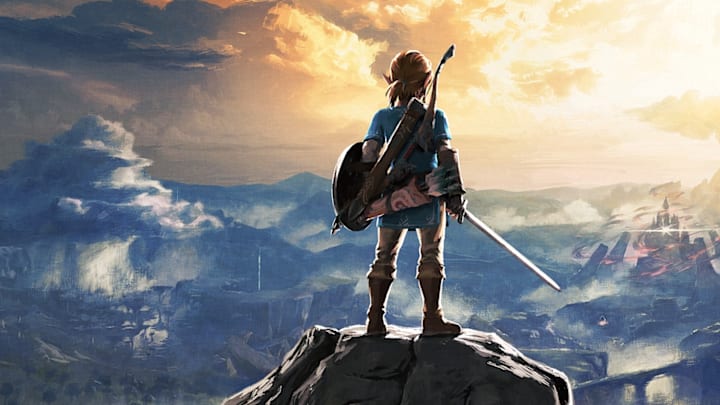The Legend of Zelda burst onto the scene in 1986, when the first game in the franchise was released as a first-party title on the Nintendo Entertainment System. Super Mario creator Shigeru Miyamoto co-designed Zelda with Takashi Tezuka, and the two visionaries managed to release their foray into fantasy months before other popular franchises like Dragon Quest and Final Fantasy, beating their competitors to the punch.
The Legend of Zelda casts players in the role of Link, a sword-wielding fantasy hero out to save a kingdom from a great evil. There had never been a game like Zelda before, and the initial response from testers was closer to confusion than celebration. Where were the jumps? The platforms? In Zelda, you could go in any of the cardinal directions and explore the world to complete your quest. This was a revelation.

Games had been evolving quickly, especially in Japan, but before The Legend of Zelda, the graphical capabilities of contemporary tech just weren't capable of rendering the lush worlds from from fantasy stories like J.R.R. Tolkien’s The Lord of the Rings with any kind of efficacy. The novelty and immersion that Zelda offered helped garner it a massive following. From here, the franchise continued to make inroads until it has now risen as one of the most popular video game franchises of all time, especially with its last two releases Breath of the Wind and Tears of the Kingdom, where the series gets an open-world makeover.
So much has changed between the 1986 version of Zelda and the ones we know today. However, the ethos of the game has stayed very much the same, espousing the Miyamoto-esque design style that has since been adopted company-wide at Nintendo. For the designers, it’s all about keeping enough of the same symbology and story to trigger nostalgia in longtime fans while also innovating with each game to create new ones. And at its heart, The Legend of Zelda will always be about what inspired it. Famously, Miyamoto credits spending time hiking and exploring nature in his youth as his inspiration when it came to creating the world of Zelda. That shows perhaps even more clearly in Tears of the Kingdom, a game released in 2023, than it did in 1986.
This being a Winter is Coming article written by yours truly, I would be remiss if I didn’t mention another Zelda connection that is near and dear to my heart concerning one of history's greatest film directors. Takeski Tezuka, the director of the 1993 Zelda game Link’s Awakening, cites Lynch's TV show Twin Peaks as a major influence for Link’s first Game Boy adventure. Starting with this connection, it’s easy to see how The Legend of Zelda franchise has been and continues to be both an active participant in and arbiter of pop culture.
For the rest of this article, we’re going to dig into the game’s iconic symbols and discuss how a love for Link and Zelda has spread into pretty much every niche of popular culture imaginable.

Symbols
Another Zelda-specific charm is how the game introduces itself with very similar iconography regardless of what console it's on or what design palette it’s adhering to. From the original Legend of Zelda to Ocarina of Time, from The Wind Waker to A Link Between Worlds, you play as a different version of Link, the main hero of the franchise. You wear your ancestral green hat proudly, you are given a sword and shield during the tutorial. Chances are your first swipes are aimed at grass that needs cutting or pots that you can break with a single hit. Inside you will find rupees, the currency of Zelda games since day one. And it’s impossible to forget about the fabled Triforce, the three-sided symbol that holds immense mystical power.
Since 1986, these little gestures and symbols have grown from a video game’s identifying tutorial elements into cultural references in their own right. They’re so pervasive that a youth ultimate frisbee team from North Carolina goes by the name Triforce, so genuinely joy-inducing that fans keep coming back to Zelda to cut slightly different grass and break similarly patterned pots time after time after time.
Seeping Through
The Legend of Zelda franchise has been a cultural touchstone for nearly 40 years. And with the massive popularity of its two recent open world titles, which sold over 50 million copies combined, Link and Zelda have become household names across the world. The games have inspired everything from poetry chapbooks, to Megan Fox and Machine Gun Kelly cosplay, meta references by Bart Simpson in The Simpsons Game, and even a plagiarism allegation brought against Coldplay by a lesser-known American band in 2008. Meanwhile, the games have garnered testimonials from countless celebrity fans including Robin Williams (who named his daughter Zelda after the eponymous princess), Captain America actor Chris Evans, and everybody’s favorite hobbit Elijah Wood (who is lesser known as a video game voice actor in games like Broken Age and Spyro).
While a variety of factors have led to Nintendo’s elf knight in little green clothing winning the hearts of so many adoring fans, one thing is sure: as far as its cultural currency is concerned, Zelda will live in the hearts of millions as long as there are games to play. And with its proven track record of reinventing itself with each iteration of consoles and epochs, the franchise deserves the love. In that spirit, here’s to many more years of cutting the grass and smashing patterned pots.
To stay up to date on everything fantasy, science fiction, and WiC, follow our all-encompassing Facebook page and Twitter account, sign up for our exclusive newsletter and check out our YouTube channel.
